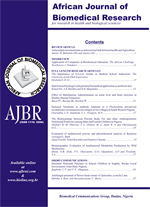
|
African Journal of Biomedical Research
Ibadan Biomedical Communications Group
ISSN: 1119-5096
Vol. 10, No. 2, 2007, pp. 127-132
|
 Bioline Code: md07017
Bioline Code: md07017
Full paper language: English
Document type: Research Article
Document available free of charge
|
|
|
African Journal of Biomedical Research, Vol. 10, No. 2, 2007, pp. 127-132
| en |
Relationship between Fasting Plasma Glucose and Glycated Haemoglobin In Adult Diabetic Nigerians
Akinloye, O.A; Adaramoye, O.A; Akinlade, K.S; Odetola, A. A. & Raji, A.A.
Abstract
The relationship between packed cell volume (PCV), fasting plasma glucose (FPG) and glycated haemoglobin (HbAI) was investigated in 40 diabetic patients (22 males and 18 females) and 20 apparently healthy controls (12 males and 18 females). Among the control subjects the FPG and HbA1 were significantly higher in the female than male subjects (P < 0.001). This gender differences was not found in diabetic patients (P < 0.05). While all the control subjects have FPG and HbA1 level within normal range (75- 115mg/dl and 5 – 8 %, respectively), 15 (38%) of the diabetic patients had FPG level within normal and only 5 (13%) had HbA1 level within the normal range. The FPG and HbA1 values were however, significantly higher in diabetic patients (139.34 ± 7.06 and 12.09 ± 2.80) than control subjects (76.40 ± 1.24 and 6.24 ± 0.51), respectively (P < 0.001). The PCV in controls correlated significantly with FPG and HbA1 (P < 0.001) while the FPG correlated significantly with HbA1 (P < 0.001). There was however only a significant correlation between FPG and HbA1 in the diabetic subjects. Bland Ahman graph shows a good agreement between FPG and HbA1, in both test and control subjects. These results show that PCV and gender factors have significant influence on FPG and HbA1 level in control subjects and were insignificant in diabetic patients. FPG and / or HbA1 are important and agreeable indices for assessment of glucose metabolism. Furthermore, there was an evidence of poor glycemic control in diabetic patients investigated in this study, probably due to poor compliance culture of the patients or inability to procure recommended drugs.
|
| |
© Copyright 2007 - Ibadan Biomedical Communications Group
|
|
